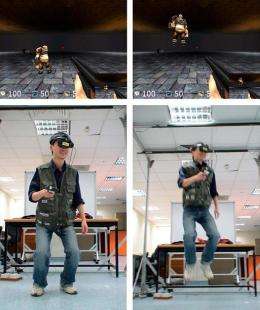In the virtual reality game, the player’s avatar mirrors the player’s actions. Credit: Tedjokusumo, et al. ©2009 IEEE.
(PhysOrg.com) -- With a new immersive multiplayer game system, researchers are further blurring the line between gaming and the real world. Using a mouse and keyboard sounds kind of quaint compared to the system developed and tested by Jefry Tedjokusumo, Steven ZhiYing Zhou, and Stefan Winkler of the National University of Singapore (Winkler is currently with Symmetricom in San Jose, California).
The game designers have created a few varieties of a first-person shooter (FPS) game in which players use a gun or sword to battle other players. In a game called “Death Match,” the goal is to kill as much as possible until one player’s health level reaches zero, which ends the game. The traditional way to do this is with a keyboard and mouse, but in the new study, the researchers have developed game systems in both a virtual reality environment and an augmented reality environment (where gaming imagery is superimposed on a player’s view of the real world).
“Unlike traditional FPS games where the user usually sits and controls the game using a joystick/keyboard/mouse, our immersive game system forces the user to move his or her entire body to aim, run, jump, crouch etc,” Tedjokusumo told PhysOrg.com. “Our immersive system can also be used to train for shooting accuracy, and the result will be very close to the real world performance.”
In the virtual reality system, players wear head-mounted displays and play the game in a rectangular room without obstacles. The head-mounted display provides each player with an image of the scene in front of them, which is the equivalent to the view on a computer or TV screen. Each player also carries a wand, which can be set up to be used as either a gun or a sword. Both the head-mounted display and the wand are tracked by a tracking system inside the room, and players receive feedback in real time. As players move through the room, they can find and pick up virtual game items, such as bullets, armor, weapons and health. Besides walking, players can also jump to dodge enemy bullets, and the player’s avatar mirrors the player’s actions.
The augmented reality system is similar to the virtual reality system, except that a player’s head-mounted display has a camera mounted in front to capture the player’s real-world view, and the game can be played in any open environment. The researchers built a game engine to calibrate the real-world data with the gaming environment (which includes the player’s weapon, other virtual game items, and sound effects). In this system, players move around in the real world using a virtual gun or sword to shoot or slash other players.
For both games, the researchers developed a novel method for presenting the player’s view and the weapon’s view separately. With this feature, players can turn their heads to look in various directions while aiming their weapon in a different direction, even if it’s out of the player’s view. To enable the players to aim, a small window called Gun Radar appears at the bottom of the screen, showing the weapon’s point of view. With two different points of view, players can shoot in any direction, even behind their backs.
The researchers invited volunteers to test both new gaming systems, and measured the results through subjective and objective methods. In the subjective user study, volunteers reported that they preferred the virtual reality game mode over both the augmented reality and keyboard/mouse modes. However, the objective user study showed that the keyboard and mouse mode allowed for more accurate aiming of bull’s-eye targets in the virtual world. Overall, volunteers preferred the virtual reality mode since it exactly mimicked their own physical movements, including full-body movements, neck movements, and weapon aiming.
“We are currently promoting the mixed/augmented reality system to the mass market,” Tedjokusumo said. Zhou’ company, MXR Corporation (www.mxrcorp.com/), is in charge of this project. On the other hand, the virtual reality system was made for specific research purposes since it uses an expensive, sophisticated tracking system. To learn more about this game, visit the Interactive Multimedia Lab (www.iml.org.sg/).
More information: “Immersive Multiplayer Games With Tangible and Physical Interaction.” Jefry Tedjokusumo, Steven ZhiYing Zhou, and Stefan Winkler. IEEE Transactions on Systems, Man, and Cybernetics - Part A: Systems and Humans. To be published.
Copyright 2009 PhysOrg.com.
All rights reserved. This material may not be published, broadcast, rewritten or redistributed in whole or part without the express written permission of PhysOrg.com.



















